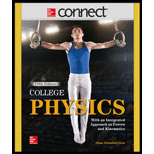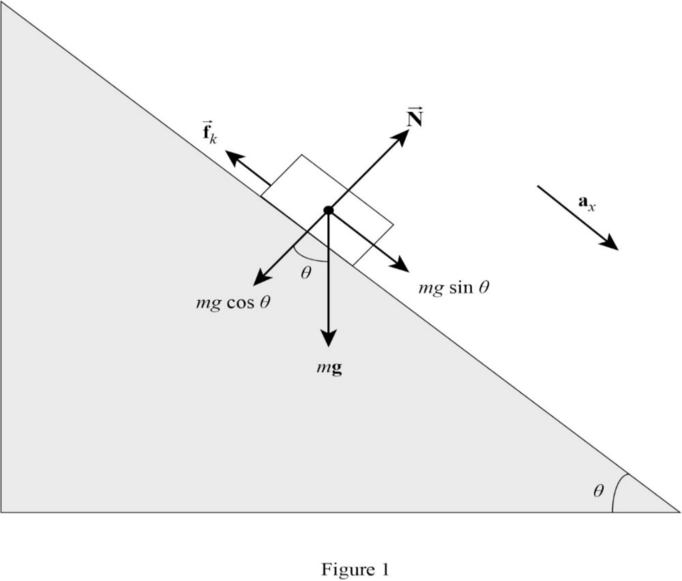
Concept explainers
(a)
The amount of energy dissipated by friction.
(a)
Answer to Problem 100P
The amount of energy dissipated by friction is
Explanation of Solution
Figure 1 represents the free body diagram of the crate.

For an isolated system the total energy of the system (the sum of mechanical energy and its internal energy) is conserved.
Here,
In this situation, the work done by the frictional force is equal to the change in internal energy of the system.
The above equation is reduced to.
Here,
Since the final velocity of the crate is zero and the distance travelled along incline is given by
Here,
Rearrange the above equation.
Conclusion:
Substitute
Therefore, the amount of energy dissipated by friction is
(b)
The coefficient of the sliding friction.
(b)
Answer to Problem 100P
The coefficient of the sliding friction is
Explanation of Solution
Write the expression for net force acting along y direction.
Apply the above condition in Figure 1.
Write the expression for internal energy dissipated by friction.
Here,
Use the above equation in equation (III).
Rearrange the above equation to find
Conclusion:
Substitute
Therefore, the coefficient of the sliding friction is
Want to see more full solutions like this?
Chapter 6 Solutions
COLLEGE PHYSICS-CONNECT ACCESS
 College PhysicsPhysicsISBN:9781305952300Author:Raymond A. Serway, Chris VuillePublisher:Cengage Learning
College PhysicsPhysicsISBN:9781305952300Author:Raymond A. Serway, Chris VuillePublisher:Cengage Learning University Physics (14th Edition)PhysicsISBN:9780133969290Author:Hugh D. Young, Roger A. FreedmanPublisher:PEARSON
University Physics (14th Edition)PhysicsISBN:9780133969290Author:Hugh D. Young, Roger A. FreedmanPublisher:PEARSON Introduction To Quantum MechanicsPhysicsISBN:9781107189638Author:Griffiths, David J., Schroeter, Darrell F.Publisher:Cambridge University Press
Introduction To Quantum MechanicsPhysicsISBN:9781107189638Author:Griffiths, David J., Schroeter, Darrell F.Publisher:Cambridge University Press Physics for Scientists and EngineersPhysicsISBN:9781337553278Author:Raymond A. Serway, John W. JewettPublisher:Cengage Learning
Physics for Scientists and EngineersPhysicsISBN:9781337553278Author:Raymond A. Serway, John W. JewettPublisher:Cengage Learning Lecture- Tutorials for Introductory AstronomyPhysicsISBN:9780321820464Author:Edward E. Prather, Tim P. Slater, Jeff P. Adams, Gina BrissendenPublisher:Addison-Wesley
Lecture- Tutorials for Introductory AstronomyPhysicsISBN:9780321820464Author:Edward E. Prather, Tim P. Slater, Jeff P. Adams, Gina BrissendenPublisher:Addison-Wesley College Physics: A Strategic Approach (4th Editio...PhysicsISBN:9780134609034Author:Randall D. Knight (Professor Emeritus), Brian Jones, Stuart FieldPublisher:PEARSON
College Physics: A Strategic Approach (4th Editio...PhysicsISBN:9780134609034Author:Randall D. Knight (Professor Emeritus), Brian Jones, Stuart FieldPublisher:PEARSON





